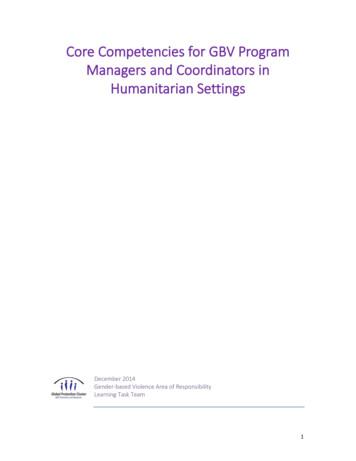MULTIVARIABLE FEEDBACK DESIGN - GBV
MULTIVARIABLEFEEDBACK DESIGNJ.M. MaciejowskiCambridge UniversityandPembroke College, CambridgeAddison-Wesley Publishing CompanyWokingham, England Reading, Massachusetts Menlo Park, CaliforniaNew York Don Mills, Ontario Amsterdam BonnSydney Singapore Tokyo Madrid San Juan
ContentsPrefacevList of symbols and abbreviations1 Single-loop Feedback Design1.11.21.31.41.51.61.7Overview and prerequisitesReview of elementary feedback designA standard problemFundamental relationsThe'shape'of the solutionTwo approaches to designLimitations on performance1.7.1 Gain-phase relationships1.7.2 Right half-plane zeros1.7.3 Right half-plane poles1.7.4 Bode's integral theoremSummaryExercisesReferences2 Poles, Zeros and Stability of Multivariable Feedback Systems2.12.22.32.42.52.62.7IntroductionThe Smith-McMillan form of a transfer-function matrixPoles and zeros of a transfer-function matrixMatrix-fraction description (MFD) of a transfer functionState-space realization from a transfer-function matrixHow many zeros?Internal 5255ix
XCONTENTS2.82.92.102.1134The generalized Nyquist stability criterionThe generalized inverse Nyquist stability criterionNyquist arrays and Gershgorin bandsGeneralized stabilitySummaryExercisesReferencesPerformance and Robustness of Multivariable Feedback Systems59626469707174753.1 Introduction3.2 Principal gains (singular values)3.3 The use of principal gains for assessing performance3.4 Relations between closed-loop and open-loop principal gains3.5 Principal gains and characteristic loci3.6 Limitations on performance3.6.1 Gain-phase relationships3.6.2 Right half-plane zeros and poles3.7 Transmission of stochastic signals3.8 The operator norms G 2 and \\G\\X3.9 The use of operator norms to specify performance3.10 Representations of uncertainty3.10.1 Unstructured uncertainty3.10.2 Structured uncertainty3.10.3 Uncertainty templates3.11 Stability robustness3.11.1 Unstructured uncertainty3.11.2 Structured uncertainty3.11.3 Loop failures and gain variations3.12 Performance variable Design: Nyquist-Iike 70176IntroductionSequential loop closingThe characteristic-locus method4.3.1 Approximate commutative compensators4.3.2 Design procedure4.4 Design example4.5 Reversed-frame normalization4.6 Nyquist-array methods4.6.1 Compensator structure4.6.2 The inverse Nyquist-array (INA) method4.6.3 The direct Nyquist-array (DNA) method
CON WNTS56xi4.7Achieving diagonal dominance4.7.1 Cut and try4.7.2 Perron-Frobenius theory4.7.3 Pseudo-diagonalization4.8 Design example4.8.1 The design4.8.2 Analysis of the design4.8.3 Comparison with the characteristic-locus design4.9 Quantitative feedback theory4.10 Control-structure 197202203210217218220Multivariable Design: LQG Methods2225.1 Introduction5.2 The solution of the LQG problem5.3 Performance and robustness of optimal state feedback5.4 Loop transfer recovery (LTR)5.5 Design procedure for square plant5.6 Shaping the principal gains5.7 Some practical considerations5.8 Design example5.8.1 Kalman-filttr design5.8.2 Recovery at the plant output5.8.3 Comparison with previous designs5.9 Non-minimum-phase 43244244252258259261262263The Youla Parametrization and Hx Optimal 932932942956.46.5IntroductionA motivating example: sensitivity minimizationThe Hx problem formulation6.3.1 Examples of Hx problems6.3.2 Performance robustness: an unsolved problemThe Youla (or Q) parametrization6.4.1 Fractional representations6.4.2 Parametrization of all stabilizing controllers6.4.3 All stabilizing controllers are observer-based6.4.4 Parametrization of closed-loop transfer functionsSolution of the Я ш problem6.5.1 Equivalence to the model-matching problem6.5.2 Equivalence to the Hankel approximation problem6.5.3 1-block, 2-block and 4-block problems
xiiCONTENTS6.6 The Hankel approximation problem6.6.1 The Hankel norm6.6.2 Glover's algorithm6.7 The Glover-Doyle algorithm for general Hx problems6.8 Design example6.8.1 Design specification6.8.2 Application of the Glover-Doyle algorithm6.8.3 Adjustment of у and weights6.8.4 Comparison with previous designs6.9 Review and comments6.9.1 The Youla parametrization6.9.2 Alternative approaches to Hx optimal controlSummaryExercisesReferences7 Design by Parameter Optimization7.1 Introduction7.2 Edmunds' algorithm7.2.1 The algorithm7.2.2 Comments on Edmunds' algorithm7.2.3 A refinement of the algorithm7.2.4 Design example7.3 The method of inequalities7.4 Multi-objective optimization7.4.1 Formulation7.4.2 Solution7.4.3 Example7.5 ConclusionSummaryExercisesReferences8 Computer-aided Design8.1 Introduction8.2 Elements of numerical algorithms8.2.1 Conditioning and numerical stability8.2.2 Solution of Ax b when A is square8.2.3 Householder transformations and QR factorization8.2.4 The Hessenberg form of a matrix8.2.5 The Schur form of a square matrix8.2.6 Eigenvalues8.2.7 Singular-value decomposition8.2.8 Generalized eigenvalues8.3 Applications to linear systems8.3.1 Frequency-response evaluation8.3.2 Characteristic loci and principal 5355356356357359362363366366367368368370
CONTENTS8.3.3 Interconnections of systems8.3.4 Inverse systems8.3.5 Minimal realizations8.3.6 Partial-fraction decomposition8.3.7 Transmission zeros8.3.8 Root loci8.3.9 Balanced realizations and model approximation8.3.10 Algebraic Riccati equations8.4 Software for control engineering8.4.1 Mathematical software8.4.2 Software packages8.4.3 Current 6389390393394394395397399400402Appendix: Models used in Examples and Exercises405Index409
3 Performance and Robustness of Multivariable Feedback Systems 75 3.1 Introduction 75 3.2 Principal gains (singular values) 76 3.3 The use of principal gains for assessing performance 81 3.4 Relations between closed-loop and open-loop principal gains 87 3.5 Principal gains and characteristic loci 91 3.6 Limitations on performance 94
Lectures on Multivariable Feedback Control Ali Karimpour Department of Electrical Engineering, Faculty of Engineering, Ferdowsi University of Mashhad (September 2009) Chapter 2: Introduction to Multivariable Control 2-1 Multivariable Connections 2-2 Multivariable Poles 2-2-1 Poles from State Space Realizations 2-2-2 Poles from Transfer Functions
376_069 Multivariable feedback control V1 1 of 428 MULTIVARIABLE CONTROL SYSTEMS DESIGN* by Ian K. Craig * These viewgraphs are based on notes prepared by Prof. Michael Athans of MIT for the course "Multivariable Control Systems 1 & 2" These viewgraphs should be read in conjunction with the textbook: S Skogestad, I Postlehwaite .
Relay feedback and multivariable control Abstract This doctoral thesis treats three issues in control engineering related to relay feedback and multivariable control systems. Linearsystems with relay feedback is the first topic. Such systemsare shown to exhibitseveral interesting behaviors.
The typical structures of the multivariable feedback control systems considered in this paper are shown in Fig.1(a) and 1(b). For convenient, this kind of structures are called "layer-wrapped structures". The precompensating matrix for an N N multivariable feedback control system is implemented by cascading the determined columns P i N ( 1,2
GBV. Increase public awareness of GBV by moving away from the mere 16 days of activism to a robust 365 days campaign against GBV and encourage every citizen to take specific steps to prevent GBV in both the private and public arena. In light of the recommendations made the Government UN GBV JP facilitated a one day workshop
3.4 General form of multivariable control system 3.5 Closed Loop Transfer Function Matrix with Feedback 3.6 Inverse Nyquist Diagram of ̂ () 3.7 Full State Feedback Control 3.8 Full State Feedback Observer Block Diagram 3.9 Full Order Observer and Controller Block Diagram 3.10 Compensator Arrangement Block Diagram
managing a GBV program with an NGO or coordinating a GBV working group. GBV coordinators can and are recruited without GBV program management experience and sometimes move from coordination into program management positions. Many GBV Program Managers do not move
Created and organised by The Interface Mechanical Civil ‘Thou’ (μm) 1/16 (mm) EN 13001-02 Regular, Variable, & Occasional Loads























